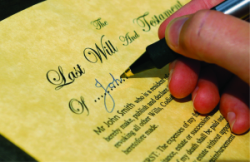Financial Briefs
Email This Article To A Friend
Rolling Over A 401(k) To A Non-Spouse
If you participate in a 401(k) or other employer plan, you have to designate who receives the assets when you die. Typically, you’ll name your spouse, though you might also choose a child, grandchild, or favorite niece or nephew. You can also decide to spread the wealth by designating multiple beneficiaries. Yet while the choice is yours, keep in mind that it could have tax implications.
 In the not-so-distant past, tax rules clearly favored spousal beneficiaries. Then as now, a spouse could roll over inherited funds tax-free into his or her own IRA, and required minimum distributions (RMDs) would be based on that person’s life expectancy. Until a recent rule change, though, anyone other than a spouse who inherited the account had much less palatable choices. Non-spouses had to take an immediate lump-sum distribution, often resulting in a massive tax bill, or empty out the account within five years, which was only slightly less punishing.
In the not-so-distant past, tax rules clearly favored spousal beneficiaries. Then as now, a spouse could roll over inherited funds tax-free into his or her own IRA, and required minimum distributions (RMDs) would be based on that person’s life expectancy. Until a recent rule change, though, anyone other than a spouse who inherited the account had much less palatable choices. Non-spouses had to take an immediate lump-sum distribution, often resulting in a massive tax bill, or empty out the account within five years, which was only slightly less punishing.
But then came the Pension Protection Act of 2006 (PPA). It lets a non-spouse roll over funds from the decedent’s account, much as a spouse would, although there are a few extra wrinkles.
Initially, the IRS interpreted the PPA provision to mean that a non-spouse beneficiary who inherited a 401(k) could roll it over only if the plan sponsor agreed to accommodate the transfer. That’s not what Congress had intended, though. Under new proposed legislation, this option became mandatory for non-spouse beneficiaries in all 401(k) plans, effective January 1, 2009.
However, calling the post-death transfer of funds a rollover is a bit of a misnomer. It is actually a transfer from one account to another that must remain titled in the name of the decedent. For instance, suppose that Jack Hill inherits an account from his aunt Jill. The name on the IRA should read, “Jack Hill as beneficiary of Jill Hill.” In contrast, if Jack had been Jill’s spouse, the IRA could have been titled as if he had owned it all along.
More significantly, the asset switch must be a direct “trustee-to-trustee” transfer. A non-spouse beneficiary can’t touch the funds or take 60 days to redeposit them in an IRA the way a spousal beneficiary could. Also unlike a spousal heir, a non-spouse can’t move the cash into an existing IRA. The funds must be deposited in a new IRA set up for this purpose. Finally, a non-spouse beneficiary can’t wait until age 70½ to begin taking RMDs. This option is still available only to spousal beneficiaries.
Despite these restrictions, non-spouse beneficiaries get a huge lift from the PPA. For example, if you’ve named your 50-year-old child as a beneficiary, he or she should be able to stretch out withdrawals from the account based on a life expectancy of 34 years, according to IRS-approved tables. That’s a whole lot better than a forced five-year withdrawal.
The exact calculation depends on whether the IRA owner had started receiving RMDs before death. This is a complex area of tax law. But we are here to help you ensure that your heirs get the full benefit of your generosity.